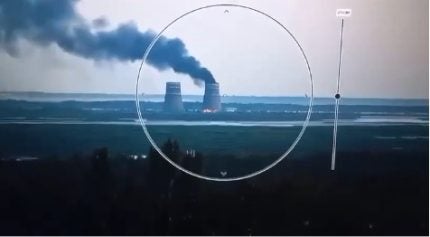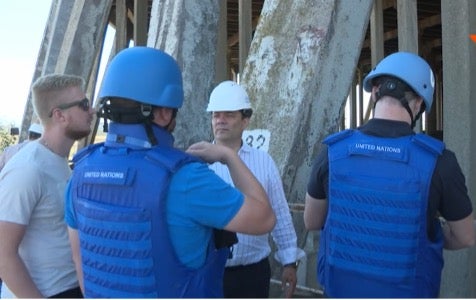
International Atomic Energy Agency (IAEA) inspectors have visited the cooling tower at the Zaporizhia NPP (ZNPP) that was damaged in a drone attack on 11 August. They were accompanied by ZNPP Director, Yuriy Chernichuk, who clarified that there was no visible damage to the cooling tower’s load-bearing structures but said everything needs to be evaluated by specialists. Immediately after the event, ZNPP Communications Director Yevgenia Yashina said that “information about the consequences of a kamikaze drone strike by the Ukrainian Armed Forces on the cooling systems of ZNPP will be brought to the attention of IAEA inspectors”.
Although the cooling towers are some distance from the reactors, there were no injuries, and the radiation background was normal, Yashina stressed that the physical integrity of the NPP was violated, “which creates an unprecedented threat to nuclear safety”.
The governor of the Zaporozhye region, Yevgeny Balitsky, said on his Telegram channel that all six power units at ZNPP are in cold shutdown and there was no threat of a steam explosion. He urged residents of the Zaporozhye region to “remain calm” and trust “only verified and official information”.
Vladimir Rogov, Chairman of the Commission of the Public Chamber of the Russian Federation said the Armed Forces of Ukraine had attacked ZNPP with a kamikaze drone, causing a fire at the cooling tower. He said the drone was launched from the city of Nikopol, Dnipropetrovsk region, located on the right bank of the Dnieper and under the control of Kiev.
Chernichuk said it is possible that the drone that attacked the station was carrying a flammable liquid. “”By the speed with which the fire started, we can assume that there was something else – bottles of gasoline or napalm, because fire broke out very quickly and over a large area”. He added that the combat drone, “flew through the top into the space of the cooling tower and detonated”. He explained that inside the cooling tower are steam traps made of plastic, which were the main source of combustion. “The separation devices were completely burned out, and the building and supporting structures were exposed to fire.” Employees of the Ministry of Emergency Situations are quickly on the scene and extinguished the fire within a few hours.
Although the cooling towers are not currently functioning to cool the reactors, they still play a key role in the safety of the plant. Alexey Anpilogov, President of the Foundation for Support of Scientific Research & Development of Civil Initiatives (Osnovanie) noted that they had been included in the heat circuit of the ZNPP after the destruction of the Kakhovskaya dam in June 2023. “A cooling tower is a large tower in which water is cooled. Initially, the equipment was exclusively related to the heat station adjacent to the ZNPP and cooled the boiler water. However, over time, the cooling tower had to be included in the circuit of the ZNPP.” Normally, water for cooling the reactors was taken from the Kakhovsky reservoir. “The reservoir was connected to a small pond of the station, from which heat exchange was carried out with the ZNPP,” he said.
“The need for cooling towers arose after the destruction of the Kakhovskaya dam. The fact is that the water level in the Dnieper River in this area has dropped sharply by several metres and the usual system, which passed water from the pond to the reservoir and back, became impossible. As a result, the plant switched to a closed cooling cycle. “From the pond, hot water was supplied to cooling towers, cooled and sent to the NPP. That is, the cooling tower itself plays a crucial role in maintaining the thermal balance of the station,” he explained.
The Russian mission to international organisations in Vienna said it will seek the toughest possible response from the IAEA to the incident. “Russia will seek that the IAEA name the guilty party of the shelling in the area of the nuclear power plant. Further silence on this issue only exaggerates the feeling of impunity in Kiev,” the statement says.
Ukraine, for its part, denied any responsibility for the damage to ZNPP and said Russia had started the fire by “burning tyres”. Acting Permanent Representative of the Russian Federation to the international organisations in Vienna, Roman Ustinov, said Russia will raise the issue at the September session of the IAEA. He noted that Russia “has all options on the table”, including the convening of an extraordinary session of the IAEA Board of Governors. He also expressed the hope that the IAEA will quickly give an assessment based on the results of the inspection that the agency’s experts conducted at the site of the attack.

Rosatom Director General Alexey Likhachev said: “What happened at the Zaporizhia power plant … is a completely different level of such, I would say, targeted aggression directed at the infrastructure of nuclear power facilities. This has never happened before. We regard the attack not just as a provocation, but as a targeted attack on the security of the infrastructure. The second absolutely unshakable principle, the foundation of the IAEA’s security — is the integrity of the infrastructure. In this sense, both the cooling tower and water-cooling systems are key elements of the safety of a nuclear power facility.”
The initial statement from the IAEA, following the attack said experts at ZNPP had “witnessed thick dark smoke coming from the north-western area of the plant, after hearing multiple explosions throughout the evening”. It added that “the team was informed that an alleged drone attack on one of the plant’s cooling towers” had taken place. “The plant confirmed to the team that there is no risk of elevated radiation levels as there is no radioactive material in the vicinity of the alleged attack area. The team independently verified the radiation levels and confirmed it remained unchanged.”
IAEA Director General Rafael Grossi reiterated that any military action taken against the plant represents a clear violation of the five concrete principles for protecting the facility, which were established at the United Nations Security Council in May 2023. “These reckless attacks endanger nuclear safety at the plant and increase the risk of a nuclear accident. They must stop now,” he said.
However, IAEA is coming under increasing criticism from Russian officials for failing to name Ukraine as the aggressor. Russian Foreign Ministry spokeswoman, Maria Zakharova, asked in her Telegram channel “Where is Raphael Grossi and all the others? Where is there at least some imitation of the work of this UN structure in this critical area?”
The Acting Permanent Representative of the Russian Federation to International Organisations in Vienna, Roman Ustinov, said in an interview with REN TV that the only way to stop Ukraine’s attacks on ZNPP “is a clear reaction of the international community to the actions of the Armed Forces of Ukraine”. In another interview with RIA Novosti, he said: “”Let’s see how the IAEA behaves this time. For us, it is obvious that the lack of an indication of the guilty party only inflames the Ukrainian sense of permissiveness and leads to new such attacks.”
ZNPP and the nearby operator’s town of Energodar are regularly targeted by drone attacks and shelling. In his previous update on the situation at ZNPP, IAEA Director General Grossi noted that staff at the nearby Zaporizhia Thermal Power Plant (ZTPP) “were allegedly unable to go outside to start the pump that transfers water from the ZTPP inlet channel to the ZTPP discharge channel for some time due to the risk of shelling”. The transfer is important as it provides a supply of water to the sprinkler ponds and other areas of ZNPP. IAEA experts were informed that the pump was later turned back on and there was no impact to nuclear safety at the ZNPP. IAEA said their experts were continuing to monitor crucial maintenance activities across the site.
ZNPP’s official Telegram channel noted that the plant had not been damaged as a result of a Ukrainian attack on Energodar. “As a result of the Ukrainian Armed Forces’ attack on the city of Energodar, ZNPP was not damaged. The station is operating normally. All six blocks, as before, are in cold shutdown. No violations of the limits and conditions of safe operation of the NPP were recorded. Measures to ensure the nuclear safety of the ZNPP are being implemented in full. The radiation background at the NPP site, in the sanitary protection zone and in the observation zone is normal.”
ZNPP Communications Director Yevgenia Yashina confirmed Ukrainian shelling of Energodar which had left the city without electricity for several hours. ZNPP was not damaged, she said, “but about nine arrivals were recorded in the city area”.
Meanwhile, Vladimir Rogov, Chairman of the Commission of the Public Chamber of the Russian Federation on Sovereignty, told RIA Novosti that British instructors were preparing an amphibious operation by the Armed Forces of Ukraine against ZNPP. According to Rogov, preparations had been underway for the past month on the upper reaches of the Dnieper River near the Dnipro hydroelectric power station. “The Marines of the Armed Forces of Ukraine are actively preparing for the operation to cross the Dnieper River near the Zaporizhia NPP,” Rogov said.
“We are talking about two brigades of Marines of the Armed Forces of Ukraine,” said Rogov, adding that Ukrainian units from the Kherson direction, who participated in the battles on the island part of the Dnieper, had been transferred to Zaporozhye for the operation.
There have been several previous attempts by Ukraine to attack ZNPP by crossing the Dneiper. In April 2023, The Times described in detail an attack which had taken place in October 2022. According to Russia’s Defence Ministry this was the fourth time Ukrainian forces had tried to storm the ZNPP using large numbers of troops and boats – the other occasions being on 1, 2-3 and 8-9 September 2022.






